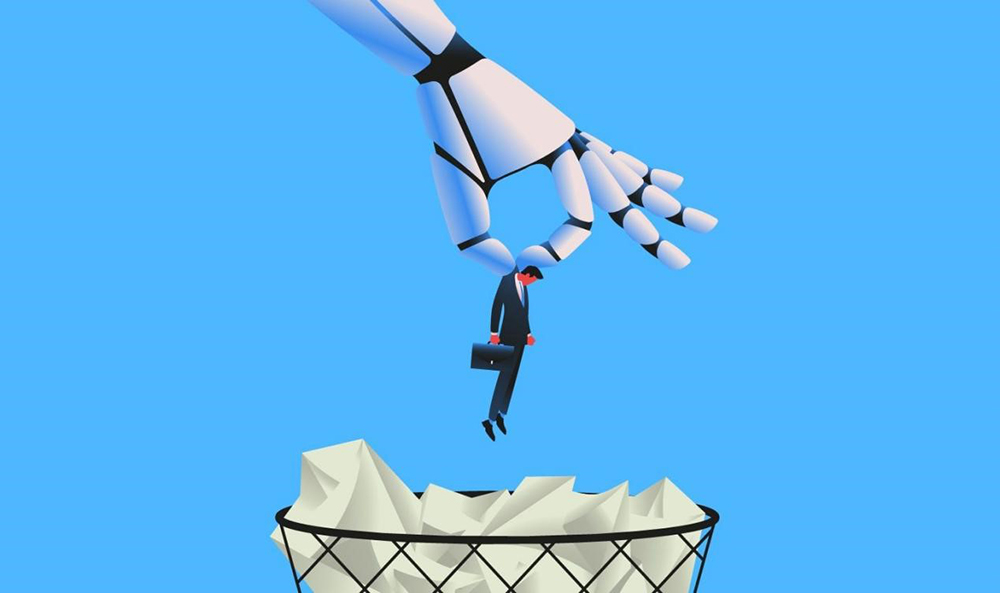
有些事情来得比预想中更快,例如堆积如山的待洗衣物、吃完一盒美味的披萨饺或亲眼目睹新技术渗透至我们的个人和职场生活。最后一件事情可能最令人感到担忧:似乎生成式人工智能劳动力时代已经来到了我们身边,而投资者则豪掷数十亿美元,开发可能带来颠覆性影响而不是不堪大用的新工具。很多员工担心会出现几乎所有的科幻小说或电影都会存在的场景,即人工智能将取代其工作。一些专家警告称会出现与人工智能相关的“噩梦级场景”,而其他人则更为乐观,并尝试消除这些恐慌。
不管是好是坏,人工智能影响的大小可能完全取决于你所从事的行业。它已经对一些领域和职位带来了冲击——IBM首席执行官宣布削减那些可由人工智能完成的工作岗位,而且有关其实施的辩论已经引发了诸多历史性事件,例如美国编剧协会(WGA)与美国影视演员协会(SAG-AFTRA)的联合示威游行。然而,人工智能也必将创造一些新的岗位,对于其他行业来说也不尽然都是坏事。
麦肯锡(McKinsey)的一项新调查报告列出了那些在未来十年受人工智能影响有可能出现增长和萎缩的行业。研究人员写道:“工作的未来已经到来,而且正在快速蔓延。”不过,它并不一定是一场公平竞争。
这家咨询公司预测,人工智能将改变人们工作的方式,并在人们从受创更为严重的行业向增长更快的行业转移之际引发转变潮。该公司估计,在2030年之前,1200多万个岗位将出现转型。以下是最有可能抵御机器人入侵的行业,以及最容易被机器人取代的行业。
面向客户的岗位和低收入岗位将会失去优势
麦肯锡预测,面向客户的岗位,例如电商和办公室行政岗位,都处在人工智能的射程范围内。麦肯锡估计,在2030年之前,在转型的1200万个岗位中,有1000万个源于食品与客户服务岗位以及办公支持和生产工作岗位数量的减少。
这些行业在过去几年中出现了员工留存和招聘问题。在大辞职潮期间,很多低收入工作人员为追求更高的收入而跳槽。在2019-2022年岗位发生变化的800多万人中,超过半数都来自于这些领域的员工。疫情并没有真正对劳动力带来真正颠覆性的影响,不过是加快了本应已经到来的现象。麦肯锡预测,这些下行趋势并非只是昙花一现,但却展现了人工智能在接下来的数十年期间可能会造成的影响。
文员岗位的需求将减少160万个,行政助理减少71万个,零售职位减少83万个,收银员减少63万个。这些岗位通常涉及注重效率的任务或涉及数据处理和搜集的重复性流程,所有这些都是人工智能能够处理的任务,至少现在是如此。
这一点与哈佛商学院(Harvard Business School)管理学教授约瑟夫·富勒的预测相吻合,他此前告诉《财富》杂志,带有更多例行工作色彩的日常联络律师或人员普遍将成为受人工智能崛起影响最大的角色。富勒对《财富》杂志说:“我并不愿意从事阅读商业书籍或对其进行概括,然后发送20页书籍摘要的工作,因为人工智能在概括方面已经做的相当好了。”
其中一些面向客户的岗位亦属于低薪岗位。麦肯锡称,到2030年,那些年薪不超过3.82万美元的人被迫更换工作的概率,是那些年薪更高员工的10-14倍。这对于有色人种、女性以及那些受教育程度不高的人来说尤为痛苦,因为他们在这些低收入工作中占比更大。麦肯锡称,客户服务职位有可能减少200万个,办公室支持职位减少370万个,这两个职位的从业人员均以女性为主。
医疗与高薪资岗位将在人工智能浪潮中胜出
另一方面,麦肯锡预测,那些在过去几年中强势增长的行业将继续发展壮大。这些都是更加稳定的岗位,包括商业和法律职位,医疗、管理、运输和理工科职位。
近一段时间,医疗行业(因无休止的加班和低薪资)经历了一些众所周知的成长痛苦,但它有可能在接下来的十年中依然稳如泰山。随着人口老化,尽管人工智能在不断崛起,但该行业的需求仍将坚挺。麦肯锡预测,医疗行业将新增350万个岗位,并新添200万个医疗专业人士。在2030年之前,运输行业岗位将迎来更为温和但依然稳定的增长,增速为9%。在2030年之前,理工科岗位需求将出现23%的激增。
麦肯锡称,尽管低薪资员工预计将不断更换工作,但收入最高的四分之一人群可能会迎来380万的岗位增幅。
我们不能因为这些行业离职的人比其他行业更少(2030年之前不到100万),就断定人工智能这头猛兽本身不会发生变化。即便这些岗位有可能维持稳定,但其日常活动可能会因新技术而发生永久性的改变。麦肯锡报告的作者称:“对于知识型员工来说,我们可以确定的最大影响就是,生成式人工智能可能会大幅改变其工作活动的内容。”(财富中文网)
译者:冯丰
审校:夏林
人工智能劳动力可能会给人们造成不同程度的影响,取决于你的薪资和行业。
有些事情来得比预想中更快,例如堆积如山的待洗衣物、吃完一盒美味的披萨饺或亲眼目睹新技术渗透至我们的个人和职场生活。最后一件事情可能最令人感到担忧:似乎生成式人工智能劳动力时代已经来到了我们身边,而投资者则豪掷数十亿美元,开发可能带来颠覆性影响而不是不堪大用的新工具。很多员工担心会出现几乎所有的科幻小说或电影都会存在的场景,即人工智能将取代其工作。一些专家警告称会出现与人工智能相关的“噩梦级场景”,而其他人则更为乐观,并尝试消除这些恐慌。
不管是好是坏,人工智能影响的大小可能完全取决于你所从事的行业。它已经对一些领域和职位带来了冲击——IBM首席执行官宣布削减那些可由人工智能完成的工作岗位,而且有关其实施的辩论已经引发了诸多历史性事件,例如美国编剧协会(WGA)与美国影视演员协会(SAG-AFTRA)的联合示威游行。然而,人工智能也必将创造一些新的岗位,对于其他行业来说也不尽然都是坏事。
麦肯锡(McKinsey)的一项新调查报告列出了那些在未来十年受人工智能影响有可能出现增长和萎缩的行业。研究人员写道:“工作的未来已经到来,而且正在快速蔓延。”不过,它并不一定是一场公平竞争。
这家咨询公司预测,人工智能将改变人们工作的方式,并在人们从受创更为严重的行业向增长更快的行业转移之际引发转变潮。该公司估计,在2030年之前,1200多万个岗位将出现转型。以下是最有可能抵御机器人入侵的行业,以及最容易被机器人取代的行业。
面向客户的岗位和低收入岗位将会失去优势
麦肯锡预测,面向客户的岗位,例如电商和办公室行政岗位,都处在人工智能的射程范围内。麦肯锡估计,在2030年之前,在转型的1200万个岗位中,有1000万个源于食品与客户服务岗位以及办公支持和生产工作岗位数量的减少。
这些行业在过去几年中出现了员工留存和招聘问题。在大辞职潮期间,很多低收入工作人员为追求更高的收入而跳槽。在2019-2022年岗位发生变化的800多万人中,超过半数都来自于这些领域的员工。疫情并没有真正对劳动力带来真正颠覆性的影响,不过是加快了本应已经到来的现象。麦肯锡预测,这些下行趋势并非只是昙花一现,但却展现了人工智能在接下来的数十年期间可能会造成的影响。
文员岗位的需求将减少160万个,行政助理减少71万个,零售职位减少83万个,收银员减少63万个。这些岗位通常涉及注重效率的任务或涉及数据处理和搜集的重复性流程,所有这些都是人工智能能够处理的任务,至少现在是如此。
这一点与哈佛商学院(Harvard Business School)管理学教授约瑟夫·富勒的预测相吻合,他此前告诉《财富》杂志,带有更多例行工作色彩的日常联络律师或人员普遍将成为受人工智能崛起影响最大的角色。富勒对《财富》杂志说:“我并不愿意从事阅读商业书籍或对其进行概括,然后发送20页书籍摘要的工作,因为人工智能在概括方面已经做的相当好了。”
其中一些面向客户的岗位亦属于低薪岗位。麦肯锡称,到2030年,那些年薪不超过3.82万美元的人被迫更换工作的概率,是那些年薪更高员工的10-14倍。这对于有色人种、女性以及那些受教育程度不高的人来说尤为痛苦,因为他们在这些低收入工作中占比更大。麦肯锡称,客户服务职位有可能减少200万个,办公室支持职位减少370万个,这两个职位的从业人员均以女性为主。
医疗与高薪资岗位将在人工智能浪潮中胜出
另一方面,麦肯锡预测,那些在过去几年中强势增长的行业将继续发展壮大。这些都是更加稳定的岗位,包括商业和法律职位,医疗、管理、运输和理工科职位。
近一段时间,医疗行业(因无休止的加班和低薪资)经历了一些众所周知的成长痛苦,但它有可能在接下来的十年中依然稳如泰山。随着人口老化,尽管人工智能在不断崛起,但该行业的需求仍将坚挺。麦肯锡预测,医疗行业将新增350万个岗位,并新添200万个医疗专业人士。在2030年之前,运输行业岗位将迎来更为温和但依然稳定的增长,增速为9%。在2030年之前,理工科岗位需求将出现23%的激增。
麦肯锡称,尽管低薪资员工预计将不断更换工作,但收入最高的四分之一人群可能会迎来380万的岗位增幅。
我们不能因为这些行业离职的人比其他行业更少(2030年之前不到100万),就断定人工智能这头猛兽本身不会发生变化。即便这些岗位有可能维持稳定,但其日常活动可能会因新技术而发生永久性的改变。麦肯锡报告的作者称:“对于知识型员工来说,我们可以确定的最大影响就是,生成式人工智能可能会大幅改变其工作活动的内容。”(财富中文网)
译者:冯丰
审校:夏林
The A.I. workforce might affect you to different degrees, depending on your salary and industry.
Some things happen more quickly than expected—like laundry piling up, finishing a good calzone, or seeing the effects of new technology seep into our personal and professional lives. The latter might be the most anxiety-producing; it seems that the age of the generative A.I. workforce is upon us, as investors pour billions into new tools that can have unprecedented consequences beyond simply being glitchy at times. Taking a cue from almost any sci-fi book or movie, many workers fear that A.I. will take over their jobs. Some experts warn of a “nightmarish scenario” related to A.I., while others are more optimistic as they attempt to cull fearmongering.
The extent of A.I.’s impact, for better or for worse, really might just depend on what industry you’re in. It’s already impacted some sectors and roles—IBM’s CEO announced plans to cut jobs that A.I. can do, and debates around its implementation have already stoked historical events such as the joint WGA and SAG-AFTRA strike. Yet A.I. is also set to create some new jobs which could give other industries something to gain.
A new McKinsey report pinpoints the sectors that will likely grow and shrink in the coming decade thanks to A.I. “The future of work is already here, and it’s moving fast,” the researchers write. It’s not necessarily a fair race, though.
The consulting company predicts that A.I. will alter how we work, creating a shift as people move from harder-hit industries to industries experiencing more growth, estimating that 12 million occupational transitions will occur by 2030. Here are the sectors most likely weather a robot takeover—and those that won’t.
Customer-facing positions and low-income roles will lose out
Customer-facing positions such as e-commerce and office admin roles are on A.I.’s chopping block, McKinsey predicts. A decrease in food and customer service jobs as well as office support and production work will lead to 10 million of the 12 million occupational shifts set to occur by 2030, it estimates.
These sectors already struggled with retention and hiring during the past couple of years; during the Great Resignation, many workers in low-paying jobs quit for better wages. More than half of the 8 million-plus occupational shifts that already occurred from 2019 to 2022 were from workers in these fields. The pandemic didn’t truly shake up the workforce as much as it sped up the conveyor belt to what might have already been coming. These downward trends aren’t just a blip but a sign of what’s to come in the ensuing decades thanks to A.I., McKinsey forecasts.
Clerk roles will decrease in demand by 1.6 million jobs, administrative assistants by 710,000 jobs, retail workers by 830,000 jobs, and cashiers by 630,000 jobs. These jobs typically involve tasks centered around efficiency or repetitive processes involving data processing and collection, all of which are tasks that A.I. can handle, at least for now.
This falls in line with predictions from Joseph Fuller, a professor of management at Harvard Business School, who previously told Fortune that routine contact lawyers or people in general with more route will be most affected by A.I.’s ascent. “I wouldn’t want to be someone who does the reading or summarization of business books to send out 20-page summaries, because A.I. is really good at summarization already,” Fuller told Fortune.
Some of these customer-facing roles are also low-paying. Those who earn $38,200 or less a year are 10 to 14 times more predisposed to have to change jobs by 2030 compared to those who make more, according to McKinsey. That’s especially painful to people of color, women, and those with less higher education, since they’re more represented in these lower-wage jobs. Customer service positions are likely to dwindle by 2 million and office support by 3.7 million, per McKinsey, both of which are roles that are women-dominated.
Health care and high-paying roles will win the A.I. wave
On the other hand, the sectors that were strong over the last couple of years will continue to thrive, McKinsey predicts. These more stable positions include business and legal roles, health care, management, transportation, and STEM jobs.
The health care industry has gone through some famous growing pains as of late (due to strenuous hours and low wages), but it’s likely to stand tall throughout the next decade. As the population ages, the sector will continue to experience demand even as A.I. rises; McKinsey predicts there will be an extra 3.5 million health care jobs and an extra 2 million for health care professionals. Those working in transportation services will see a more modest, but still stable growth of 9% by 2030. And STEM jobs are set to see a 23% hike in demand by the end of the decade.
While low-wage workers are projected to move around, those in the highest wage quartile could experience an increase of jobs by 3.8 million, according to McKinsey.
Just because fewer people are likely to leave these jobs than in other sectors (less than 1 million by 2030), that doesn’t mean the nature of the beast isn’t changing. Even if these jobs are likely to remain stable, day-to-day activities might be forever altered by the new technology. “The biggest impact for knowledge workers that we can state with certainty is that generative A.I. is likely to significantly change their mix of work activities,” note the McKinsey authors.






